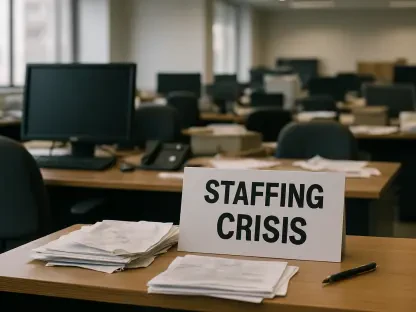Kicking off with a startling reality, nearly 68% of American workers fear they won’t have enough saved for retirement, a concern that looms large as lifespans increase and economic uncertainties persist, prompting a critical look at savings strategies. With the Internal Revenue Service (IRS) announcing updated contribution limits for 401(k) and IRA plans for 2026, there’s a renewed focus on whether these adjustments can bridge the savings gap. This roundup gathers diverse opinions, tips, and insights from industry leaders, financial advisors, and policy analysts to explore the implications of these changes, uncover differing views on retirement readiness, and offer practical guidance for navigating the evolving landscape of retirement planning.
Diving into the 2026 Retirement Plan Updates
What’s New with Contribution Limits?
On November 17, 2025, the IRS unveiled significant updates to retirement plan contribution limits for 2026, setting the stage for increased savings potential. The annual cap for 401(k) plans, along with 403(b), governmental 457 plans, and the Thrift Savings Plan, will rise to $24,500, marking a $1,000 increase from the current threshold. Meanwhile, IRA contributions will see a boost to $7,500, with catch-up contributions for those aged 50 and over reaching $1,100, reflecting legislative mandates from recent reforms.
Industry observers note that these adjustments are primarily driven by inflationary pressures, aiming to preserve the purchasing power of retirement savings. However, some financial analysts argue that while the increase is a step in the right direction, it may fall short for many facing substantial savings deficits. There’s a shared concern that incremental changes might not keep pace with rising living costs, especially for middle-income earners.
A point of contention among experts is the enhanced catch-up provisions, particularly for workers aged 60 to 63, who will benefit from even higher limits under select plans. While some see this as a targeted boost for late-career savers, others caution that it could disproportionately favor higher earners who are better positioned to maximize contributions, potentially widening existing disparities in retirement security.
Broader Implications of the Adjustments
Beyond the numbers, the raised limits have sparked discussions on their real-world impact across various sectors. Financial planners emphasize that these changes offer a critical opportunity for workers to ramp up savings, especially amid volatile markets. Yet, there’s skepticism from some policy analysts who suggest that without accompanying tax incentives or broader access to plans, the benefits might remain limited to a smaller demographic.
Contrasting views emerge on how these updates align with long-term retirement goals. Certain industry leaders highlight that the adjustments signal a governmental commitment to supporting savers, potentially encouraging more aggressive financial planning. On the other hand, critics argue that such measures are merely reactive, failing to address systemic issues like wage stagnation and the gig economy’s lack of retirement benefits.
The dialogue also touches on employer roles in leveraging these new caps. Some advisors urge companies to match contributions more generously or offer educational programs to help employees understand the changes. This perspective contrasts with concerns from smaller business owners who worry about the administrative burden of adapting to updated limits, revealing a divide in how different stakeholders perceive the practicality of implementation.
Retirement Readiness: A Spectrum of Opinions
Employer vs. Employee Perceptions
A striking disparity exists in how retirement readiness is viewed by employers and employees, as noted by multiple financial surveys. Reports indicate that over 75% of employers believe their workforce is prepared for retirement, a confidence not mirrored by workers, fewer than half of whom share this optimism. This disconnect raises questions about communication and awareness within organizations.
Analysts point out that employers often base their assessments on the availability of retirement plans, assuming participation equates to readiness. However, employees frequently cite concerns about inadequate savings and rising healthcare costs, painting a gloomier picture. Some workplace consultants suggest that this gap stems from a lack of tailored financial guidance, leaving workers uncertain about their future.
Younger generations, however, appear more hopeful, with many expressing confidence in their ability to save over time. This optimism is tempered by unique challenges like student debt and housing costs, which some experts believe could undermine long-term security if not addressed. The contrast between generational attitudes adds another layer to the complex narrative of retirement preparedness.
Fears of Insufficient Savings
The fear of outliving savings is a recurring theme among workers, with studies showing that a significant majority anticipate working well into their later years or never fully retiring. Financial educators stress that this anxiety often stems from a lack of clarity around realistic retirement needs, pushing for more transparent discussions about expenses and income sources post-career.
Differing opinions surface on how to mitigate these fears. Some advisors advocate for early intervention, encouraging workers in their 20s and 30s to prioritize retirement contributions despite competing financial pressures. Others argue that systemic solutions, such as expanded Social Security benefits, are essential to alleviate the burden on individuals, highlighting a debate over personal versus collective responsibility.
Policy researchers also weigh in, noting that the trend of delayed retirement could strain labor markets and social systems if not managed carefully. They suggest that fostering a culture of phased retirement, supported by flexible work arrangements, might ease the transition for older workers. This idea contrasts with more immediate calls for boosting financial literacy to empower savers at every stage of life.
Policy Shifts and Innovations in Retirement Planning
Modernizing Plans Under Current Leadership
Recent policy moves under the Trump administration have introduced new dimensions to retirement planning, drawing mixed reactions. An executive order issued on August 7 directed regulators to explore alternative investments like cryptocurrencies and real estate within 401(k) plans, aiming to diversify options for savers. Additionally, the Department of Labor’s self-correction policies for employer contribution errors are seen as a move toward greater flexibility.
Supporters of these changes argue that expanding investment choices could yield higher returns, particularly for tech-savvy younger workers open to non-traditional assets. However, financial regulators and risk analysts caution against the volatility of such investments, warning that they might expose savers to undue losses without proper oversight. This tension underscores a broader debate on balancing innovation with stability.
The self-correction measures also elicit varied responses. Some employer advocacy groups praise the reduced penalties as a way to encourage plan sponsorship among smaller firms. Conversely, labor representatives express concern that leniency might lead to persistent errors, ultimately harming employees. These conflicting viewpoints highlight the challenge of crafting policies that serve diverse interests in the retirement ecosystem.
Risks and Opportunities of New Approaches
Exploring alternative investments in retirement plans is viewed as both a potential boon and a significant risk by industry voices. Proponents suggest that access to assets like private equity could democratize wealth-building opportunities previously reserved for high-net-worth individuals. They argue that with proper education, workers can make informed decisions to enhance their portfolios.
Critics, however, emphasize the complexity and unpredictability of such investments, pointing out that many lack the expertise to navigate them effectively. Financial advisors often recommend a cautious approach, suggesting that only a small portion of retirement funds be allocated to speculative assets. This advice reflects a middle ground, aiming to harness opportunity while minimizing exposure to downturns.
There’s also a growing call for regulatory frameworks to keep pace with these innovations. Policy experts stress the need for clear guidelines to protect savers from fraud and mismanagement in emerging markets like cryptocurrency. This perspective contrasts with more libertarian views that favor minimal intervention, believing market forces should guide investment choices, illustrating the ongoing struggle to define the future of retirement policy.
Bridging the Knowledge Gap in Retirement Planning
The Need for Financial Education
Across the board, there’s consensus on the urgent need for improved financial literacy to support retirement planning, especially with evolving contribution limits and investment options. Experts in workforce development highlight that many employees struggle with basic concepts, such as the 4% withdrawal rule for sustainable retirement spending, often leading to unrealistic expectations.
Various sources suggest that employers are uniquely positioned to address this gap by offering workshops and resources tailored to their workforce. Some companies have seen success with gamified learning tools that make complex topics more accessible, a strategy endorsed by behavioral economists as a way to boost engagement. Yet, there’s debate over whether such initiatives should be mandatory or optional, given resource constraints for smaller firms.
Financial counselors also point to the role of technology in democratizing education, with apps and online platforms providing personalized insights. While this approach is lauded for its scalability, skeptics note that digital solutions may not reach older or less tech-savvy workers, suggesting a need for hybrid models. This diversity in delivery methods reflects the multifaceted challenge of ensuring all workers are equipped for financial security.
Who Bears the Responsibility?
The question of responsibility for closing the retirement education gap sparks lively discussion among stakeholders. Many corporate leaders argue that individuals must take ownership of their financial futures, advocating for self-directed learning as a cornerstone of personal accountability. This stance often emphasizes the abundance of free resources available to motivated savers.
In contrast, employee advocacy groups assert that employers and policymakers share a significant burden, given their influence over plan structures and economic conditions. They push for incentives that encourage companies to invest in financial wellness programs, viewing such support as a critical employee benefit. This viewpoint challenges the notion of individual responsibility as the sole solution.
Government agencies are also seen as key players, with some analysts calling for national campaigns to raise awareness about retirement planning. Others believe local community efforts, such as partnerships with financial institutions, might be more effective in reaching underserved populations. These differing ideas underscore the complexity of fostering a culture of informed saving across all levels of society.
Key Takeaways and Practical Tips from the Roundup
Synthesizing insights from various perspectives reveals that the IRS’s adjustments to 401(k) and IRA limits for 2026 are a welcome, though not transformative, update for many savers. Financial planners consistently recommend maximizing contributions as early as possible to benefit from compound growth, a strategy seen as essential regardless of income level. They also advise reviewing current retirement plans to align with the new caps, ensuring no opportunity is missed.
Differing opinions on policy innovations, like alternative investments, suggest a need for caution and education before diving into uncharted territory. Industry voices often stress the importance of diversification while warning against overexposure to high-risk assets, a balance that requires careful consideration. For employees, seeking out employer-provided resources or external financial guidance can provide clarity on navigating these options.
Practical steps also include staying informed about legislative changes that could impact retirement plans over the coming years. Some advisors suggest setting calendar reminders for annual contribution reviews, a simple yet effective way to stay proactive. These actionable tips, drawn from a range of expert inputs, aim to empower workers to take control of their financial futures amid an ever-shifting landscape.
Reflecting on the Discussion and Next Steps
Looking back on the roundup, it is evident that while the IRS’s increased contribution limits for 2026 offer a meaningful opportunity for savers, deep-seated concerns about retirement readiness persist across generations. The stark contrast in employer and employee perceptions, coupled with varied reactions to policy shifts, paints a picture of a system in flux, grappling with both innovation and uncertainty. Discussions around financial education emerged as a unifying theme, with diverse voices agreeing on its critical role in shaping outcomes.
Moving forward, a key consideration is fostering collaboration among individuals, employers, and policymakers to address systemic gaps in retirement planning. Exploring hybrid education models that combine digital tools with in-person support could ensure broader accessibility, while advocating for clearer regulatory guidelines on alternative investments might safeguard savers from potential pitfalls. These steps, alongside a commitment to ongoing dialogue, hold promise for building a more resilient framework for future retirees.









